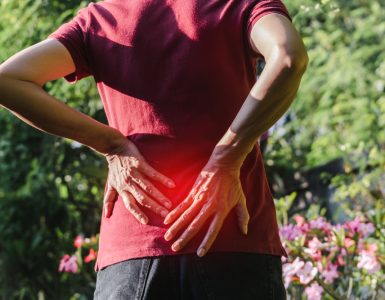Your joints perform so many crucial jobs: connecting your bones, supporting your weight and allowing you to move around. Joints are in the main, incredibly hard wearing and are designed quite literally to give a lifetime of service. Although they can cope with all the stresses that you place on them, they can sometimes suffer from wear and tear. They can also become damaged through disease or injury, leading to joint pain.
Causes of joint pain
There are several different conditions that can lead to joint pain including osteoarthritis, rheumatoid arthritis, gout, strains, sprains and other minor injuries. It can vary from person to person, and can be affected by your lifestyle and even your job. The most common form of joint pain is knee pain. This is followed by shoulder pain and hip pain, but of course it can affect any number of your joints and – unfortunately – becomes more common as we grow older.
Supplements for joint health
Devil’s Claw
Devil’s Claw is a perennial shrub that grows wild in the desert countries of Southern Africa, most notably in the Kalahari sands of Namibia. The herb takes its common name from its large thorny seedpods, which are a hazard for animals when they become entangled in their fur – its botanical name is derived from the Greek ‘harpago’ meaning a ‘grappling hook’.
How does Devil’s Claw work?
Research shows that Devil’s Claw can help relieve pain and in some cases improve mobility in people suffering from osteoarthritis or degenerative rheumatism. It is not known exactly how devil’s claw works but the anti-inflammatory properties of the active compounds called harpagosides and the plants sterols found in its roots, are thought to be responsible.
Devil’s Claw can be found in FlexiHerb – a traditional herbal medicinal product used for the relief of backache, rheumatic or muscular pain and general aches and pains in the muscles and joints.
Boswellia
Boswellia serrata is a large branching tree native to India, the Middle East and North Africa. Its thick bark is where the resin, known as boswellic acid, is found. The resin is used medicinally and is known as frankincense or olibanum.
Boswellia has been prized for its medicinal properties for thousands of years. It is especially favoured in Ayurvedic medicine as an effective treatment for conditions such as arthritis and general pain relief.
How does Boswellia work?
Boswellia’s anti-inflammatory properties have been found to be primarily due to its inhibition of someting called 5-lipoxegenase, an enzyme which can cause inflammation in the body. It has been found to help with inflammatory conditions affecting the joints, skin, digestive systems.
Boswellia works as an effective pain relief, particularly in cases of arthritis, when used over an eight-week period.
There have also been many studies to support the effectiveness of Boswellia in treating osteoarthritis with improvements in both pain, swelling and flexibility and increased ability to walk further, compared with groups taking placebos.
Nature’s Way Boswellia is aviable in packs of 60 tablets and is suitable for vegans.
Omega 3s
The omega-3s are also known as essential fats. This is because the body cannot make them and they have to be eaten very regularly in the diet. The chemical structure of these polyunsaturated fats also means they’re very healthy for the body.
Their chemical structure contains three double bonds, ensuring these fats provide flexibility for cell membranes; they are an intrinsic part of all our cellular make-up.
Plant-based vs fish-based Omega-3s
Plant-based omega-3 fats are derived from alpha linolenic acid (ALA). The body converts plant-sourced ALA, such as that found in flaxseed and walnuts, into two substances called EPA and DHA; these provide a range of positive health benefits particularly for the joints, skin, eyes, brain and hormones. However, most of the cellular health benefits are linked to animal-based EPA and DHA, found in oily fish.
How do Omega-3 fats work?
The conversion from ALA to EPA and DHA enables the body to produce prostaglandins – hormone-like compounds which provide a range of health benefits. These compounds provide positive anti-inflammatory effects throughout the whole body and therefore can help support joint health associated with inflammation. They also help to manage blood pressure, support good circulation, regulate cholesterol levels and maximise brain function.
Nature’s Way Super Fisol contains 70% EPA and DHA from sustainable sources.
What vitamins and minerals are good for joint health?
Vitamin D
Vitamin D is known as the ‘sunshine vitamin’ because it’s predominantly produced on the skin in the presence of sunlight. Living in the northern hemisphere is a risk factor for deficiency, particularly during the winter months. Such is the concern that the UK Department of Health recommends taking a supplement of a minimum of 10ug per day to ensure adequate levels.
How does Vitamin D work?
Vitamin D is famous for its role in bone health. It helps support calcium metabolism by regulating the amount of calcium and phosphorus in the blood; if blood levels are low, these minerals are pulled from the bones causing various bone complications and diseases. So important is this function that even if calcium intake and body stores are sufficient, if vitamin D is low there is still a risk of poor calcification of the bones. Vitamin D is therefore absolutely essential for healthy bones and teeth in growing children, as well as immunity for adults and children.
Several studies have also shown that reduced levels of Vitamin D can cause joint and muscle pain.
Vitamin D can be found in our range of Nature’s Way Vitamin D products and also in Alive! Vitamin D3 Gummies along with Calcium and Phosphorus.
Calcium
Calcium is the most abundant mineral in the body and, therefore, one of the most important. It has some really vital life-supporting functions, the most crucial being the growth and development of bones and teeth; bones contain more than 99% of the body’s calcium. Sufficient intake is particularly important during infancy and childhood when a strong bone structure is being built.
How does Calcium work?
As well as building strong bones and teeth, calcium is important in much of the body’s enzyme activity. The contraction of muscles, regulation of the brain’s neurotransmitters (or messaging system), regulation of the heartbeat and blood clotting, all depend on calcium.
The bones themselves provide calcium to the blood and this is partly regulated by vitamin D. So important is vitamin D in this function that a low calcium level in the body may actually be caused by a lack of vitamin D.
Magnesium works closely with calcium which supports its functions in the blood, nerves and muscles. If you have a high calcium intake but with a magnesium or vitamin D deficiency, calcium is not correctly metabolised. Therefore the correct balance of these three nutrients is key.
It is most frequently used by doctors in cases of osteoporosis, the main deficiency disease of a lack of calcium.
It can be found in Alive! Calcium Gummies.
There are a number of ways that you can help relieve joint pain and measures you can take to prevent injury and joint pain in the first place, a few of which we’ve outlined below.
Massage
Professional sportspeople often rely on massage as part of their training regimes as massage is an excellent way to achieve relief. It’s especially beneficial for knee pain relief and hip pain relief with long distance runners being particular advocates.
Exercise
Staying with the sporty theme, exercise and stretching can be a good way to relieve pain. Exercise is more of a preventative measure. It increases the strength and flexibility of muscles and structures surrounding your joints reducing the likelihood of future pain. It’s important that you don’t overdo it though as too much exercise or using the wrong equipment can cause further pain.
Rest
One of the best ways of achieving relief is through plenty of rest and relaxation. Resting your joints allows your body to restore energy and repair itself naturally. If you’re involved in a lot of physical activity, it’s important to make sure that you give yourself time to rest and recuperate in between sessions.
Physical therapy
After trying any of the remedies above, if you are still suffering from joint pain it may be worthwhile turning to a professional. A physical therapist or Osteopath specialises in human movement and can often help with joint pain relief through a number of therapy sessions.
If your joint pain persists, you should always seek professional medical advice. Make sure you schedule an appointment with your GP so that they can assess and treat your condition.













